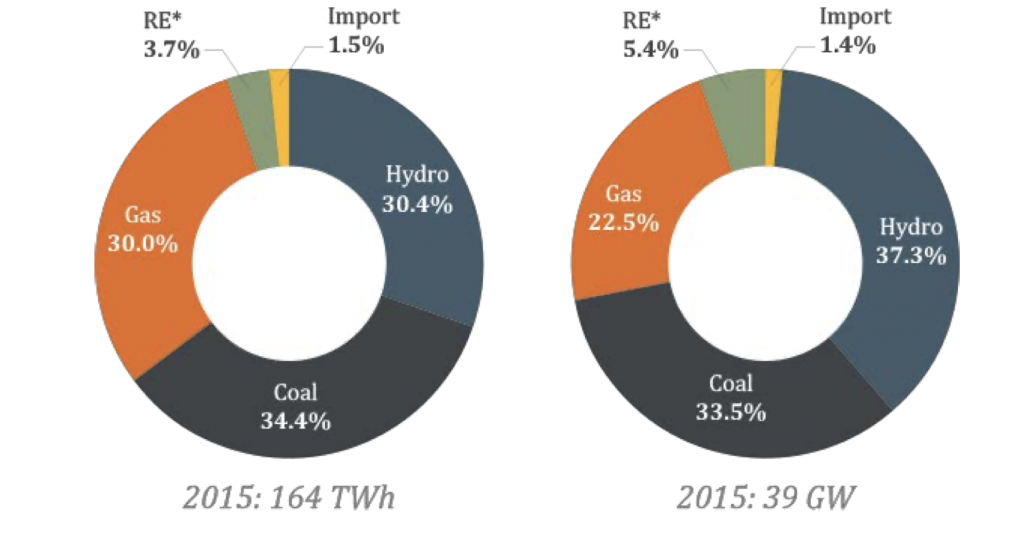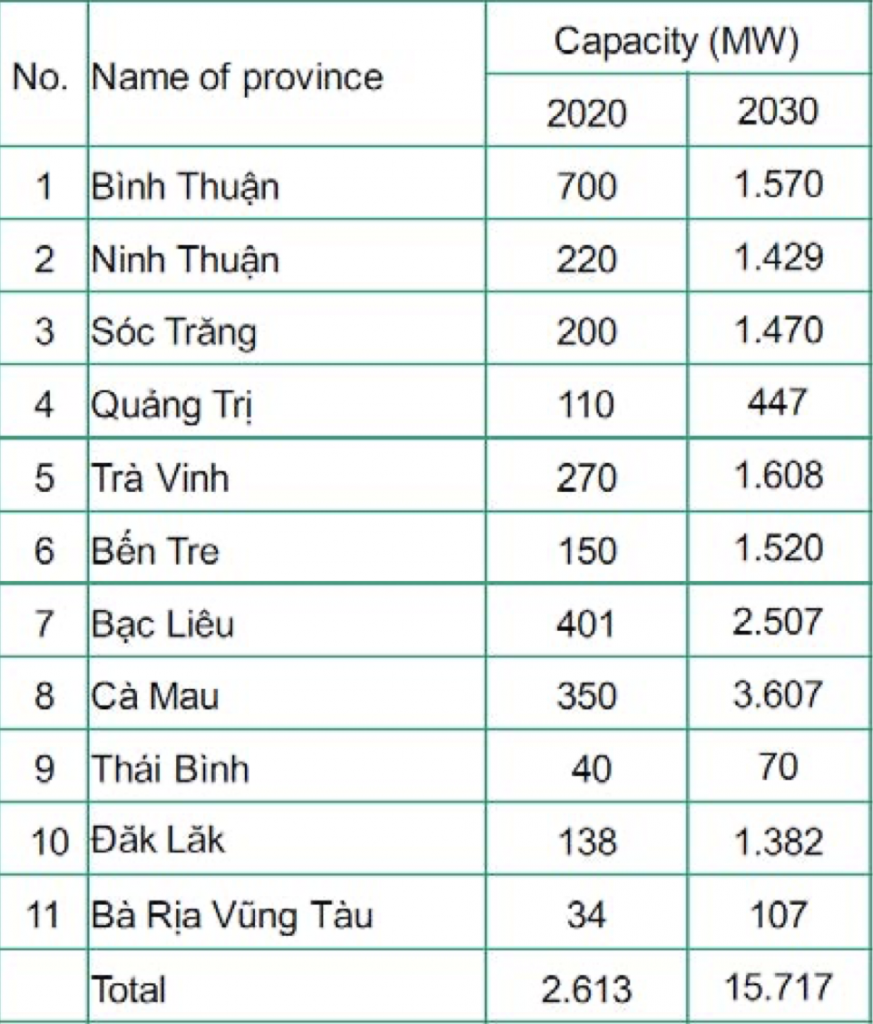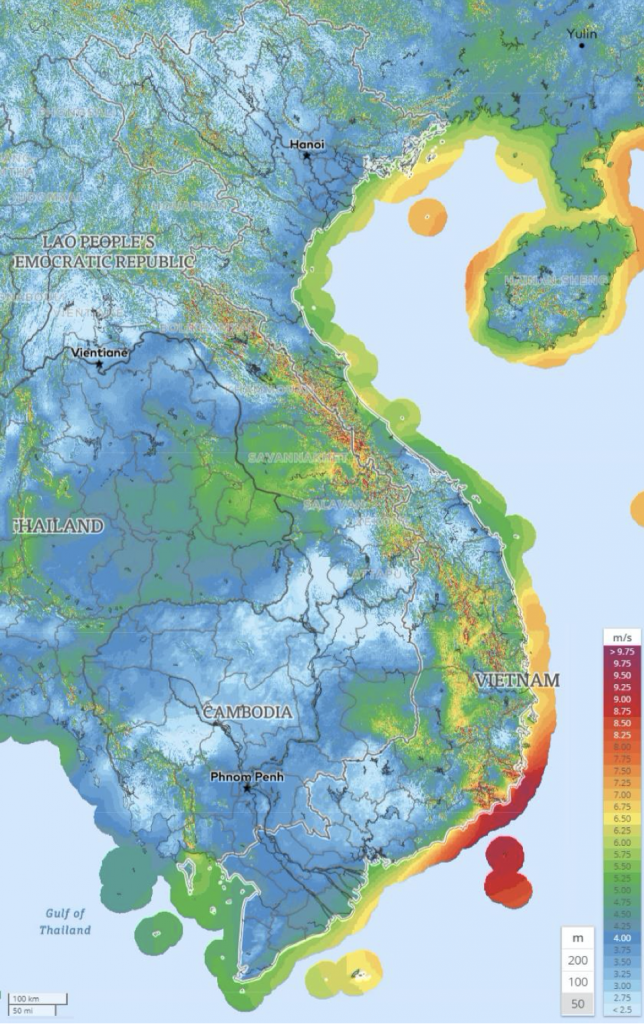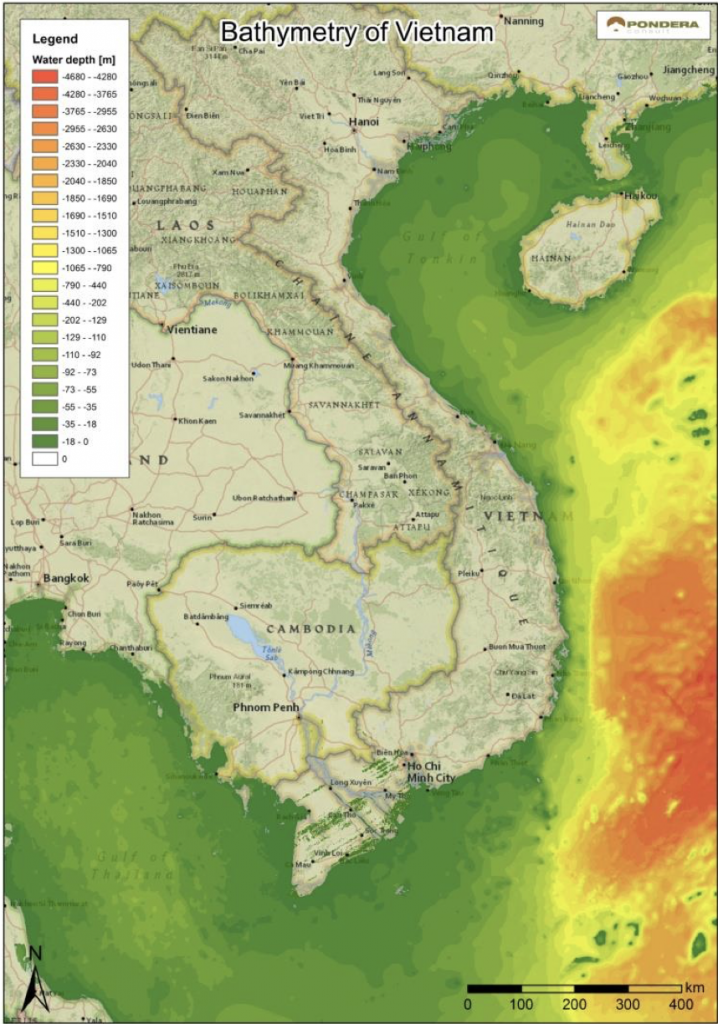in Vietnam, several wind measurement studies are conducted. Vietnam is considered to have the best wind resources in Southeast Asia, especially in the nearshore/offshore and onshore coastal regions in the south of Vietnam. In these areas yearly average windspeeds of 9 to 10 meters per second are measured. Generally, windspeeds are declining further inland.
Renewable energy targets and wind energy
Vietnam is a country with a rapidly growing economy together with an increasing energy and electricity demand. To sustain the growing electricity demand, new power plants are being built, especially coal-fired power plants. Besides fossil fuels, hydro power is also an important part of the electricity supply in Vietnam, accounting for 37,3 percent of the total installed capacity. EVN is the single buyer of electricity and holds a monopoly on transmission and distribution. Renewable energy sources are still a very small share in the total electricity production, but ambitious targets have been set by the government.
Wind farm development onshore and nearshore
A key regulatory instrument for wind power in Vietnam are the Provincial Wind Power Development Plans (PWPDPs). These plans define priority areas for wind power development, for which wind measurement has already been conducted. Specific onshore and nearshore sites are selected, based on windspeed, topography, connection and accessibility to the energy grid, land use and buffer zones between potential areas. A total installed capacity of 2.613 MW in 2020 and 15.717 MW in 2030 are allocated in the PWPDPs. The status of these designated areas are diverse: some are under development, under construction or unknown. Currently, the total installed wind power capacity is 186 MW, which is divided over four grid-connected wind farms with capacities ranging between 6 MW and 100 MW.
Wind farm development offshore
Offshore wind energy development – further off-coast than nearshore wind energy – is not yet occurring in Vietnam. Especially the coastline to the northeast of Ho Chi Minh City is very promising, due to the shallow water (ranging between 1 and 25 meters) within 50 kilometres from the shore and the highest offshore wind speeds of Vietnam.
Countries and companies already active at the Vietnamese wind energy market
Companies from countries that have been active in the Vietnamese wind energy sector for a long period of time such as Germany, Denmark, UK and USA have a better position for involvement in wind energy development than companies from, newcomer, the Netherlands. They can build on existing relationships with governments and relevant parties in the wind sector.
Overview of Vietnam energy sector
Electricity demand in Vietnam is rapidly annually increasing with 10 percent. Table 2.1 shows key indicators with respect to power demand, production, and consumption for the period 2005– 2014.
Electricity Demand and Supply
| 2005 | 2009 | 2014 | 2017 | |
| Annual Demand (TWh) | 46 | 76 | 128 | 174 |
| Annual Generation (TWh) | 54 | 87 | 146 | 197 |
| Per Capita Consumption (kWh) | 549 | 873 | 1415 | 1852 |
In 2015 the electricity production is dominated by coal with a share of 34,4% in electricity generation, followed by hydropower with 30,4% and natural gas with 30,0%. Due to limited domestic coal and gas resources, Vietnam’s imports of fossil fuels are increasing. The country turned to a net energy importer by 2015 after being net energy exporter for a long period. Except for hydropower, markets for renewable energies such as for wind and solar power are in a very early stage of development. However, the surging energy demand together with limited natural resources (coal, gas and oil), presents an important opportunity for renewable energy production in Vietnam.

Wind energy potential of Vietnam
Wind resource onshore
Vietnam is considered to have the best wind resources in Southeast Asia. Located in the monsoon climate zone, and shaped by its over 3,000 km long coastline, Vietnam ́s potential to develop and generate wind power is substantial. MOIT, with the support of the World Bank, released the Wind Resource Atlas in 2011. This report identified great potential for harnessing wind energy in Vietnam ́s south central regions and the Mekong Delta. Estimations the Wind Atlas cite around 24 GW of potential. Wind potential in Vietnam concentrates mostly in the southern central coastal region (Binh Thuan Province) and the southern coastal region (Tra Vinh, Bac Lieu and Soc Trang provinces) with average windspeeds of 7 m/s or higher.
Table below gives an overview of wind energy theoretical potential based on the Wind Resource Atlas of Vietnam (source WB report 2011). Areas with mean wind speeds of 6-7 m/s and up can be considered as especially suitable for wind power development.
Provincial Wind Power Development Plan’s

Currently, 9 (mostly southern) provinces in high potential wind energy areas, drafted a so-called Provincial Wind Power Development Plan. These potential areas are selected following certain criteria like windspeed, topography, connection and accessibility to the transmission grid, land use and buffer zones between potential areas.

Offshore and nearshore
offshore wind energy is a relatively new and emerging market in Vietnam, with huge potential. Currently the first nearshore windfarms are in operation and under development along the coast in southern Vietnam.
The average wind speed along the coastline of Vietnam at a height of 50 meters. The south-eastern region of Vietnam has the highest windspeeds along the coast of Vietnam. The region from the coastal city of Qui Nho’n to the coast near Ho Chi Minh city has wind speed of 7-11 meter per second on average, making it one of the areas with the highest potential of generating electricity from wind energy in the world.


The depth and consistency of the seabed has a major impact on the windfarm design in terms of turbine and foundation selection, size and construction. Especially the water depth plays an important role with regards to foundations options and costs. Moreover, developing offshore wind energy further away from the coastline requires more costs in terms of logistics and grid connection. The seabed along the coastline in the north, as well as in the south of Vietnam can be characterized as relatively shallow and consistent. The seabed at the height of central Vietnam is much deeper at a short distance from the shore. Clearly visible is the relatively consistent and shallow plateau along the coastline near Ho Chi Minh City. Therefore, in combination with high windspeeds , the coastline is a high potential zone for offshore wind energy. Especially the coastline to the east of Ho Chi Minh City is very promising, due to the shallow water and the highest offshore wind speeds of Vietnam within 50 kilometres from the shore.



